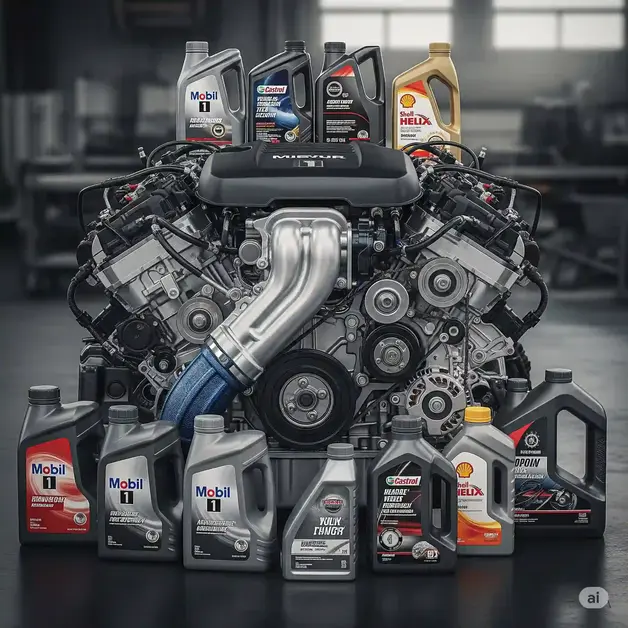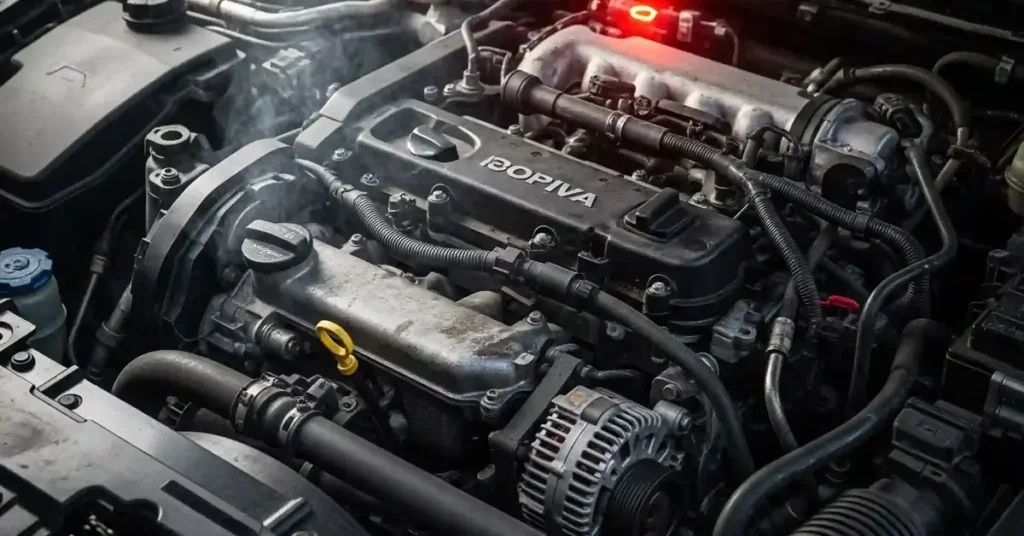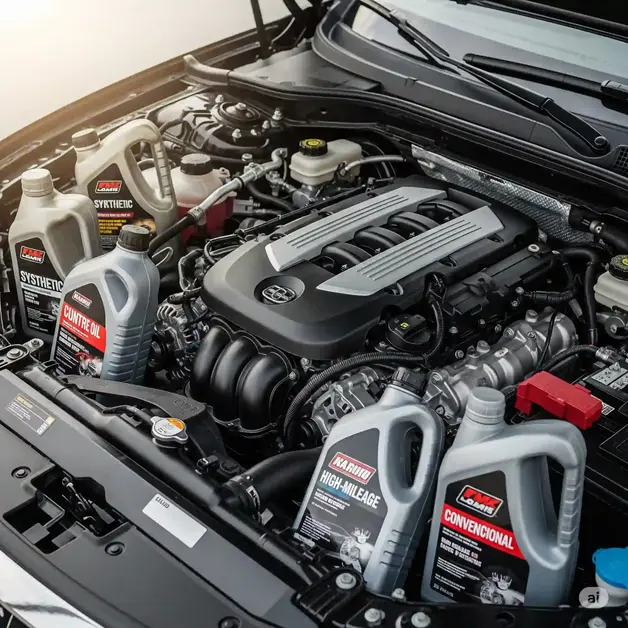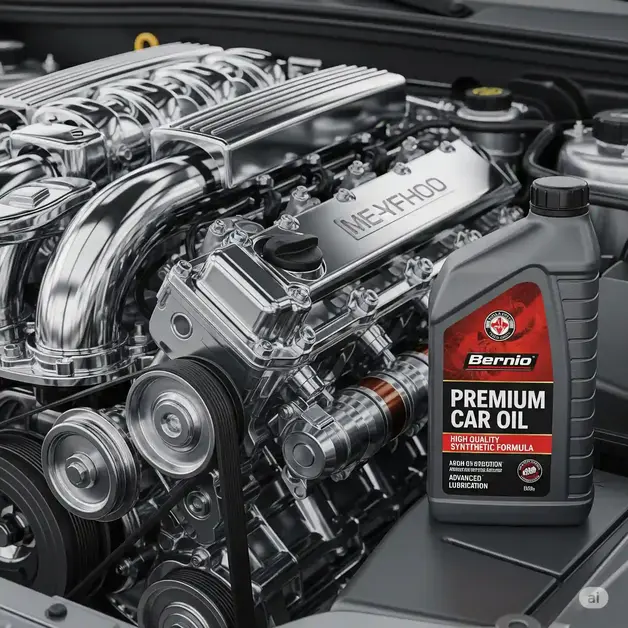I still remember the first time I had to choose motor oil on my own. I was standing in a store aisle, overwhelmed by rows of shiny bottles claiming to be the best car oil, each promising to protect my engine better than the rest. It felt like picking medicine without knowing what’s really inside. Over the years—after a few mistakes, a lot of research, and countless oil changes—I’ve learned which oils actually live up to the hype. In this guide, I’ll walk you through what I’ve discovered about the best oil for cars, how to choose the right one, and which car oil brands are truly worth your money. Whether you’re a seasoned DIYer or just want to make smarter decisions at your next oil change, I’ve got you covered.
Why Choosing The Right Car Oil Matters
A few years back, I helped a friend who had just bought a used car. It was running fine—until it wasn’t. Turns out, the previous owner had been using whatever cheap oil was on sale. The engine started knocking, the fuel efficiency dropped, and it ended up costing more in repairs than a year’s worth of proper oil changes. That moment really hit home: using the right oil isn’t optional—it’s essential.
Your car’s engine is like its heart. And just like your heart needs clean, healthy blood to function well, your engine needs clean, high-quality oil to stay strong. The best oil for car engines keeps everything running smoothly by reducing friction, cooling the engine, and preventing wear. It doesn’t just help your car perform better—it actually helps it live longer.
If you’ve ever wondered whether spending a little extra on the best engine oil is worth it, the answer is yes. Good oil forms a protective barrier between moving parts, especially when the engine is cold or under heavy load. That protection can be the difference between an engine that lasts 150,000 miles and one that dies before 100,000.
Think of it this way: engine oil is your car’s first line of defense. And choosing the right one from a trusted car oil brand ensures you’re not just guessing—you’re investing in your car’s future. So before you go for that bargain-bin oil, ask yourself: is saving a few bucks today worth risking a costly breakdown tomorrow?
Types of Car Oils Explained (and Which One You Should Use)
When I first started doing my own oil changes, I was surprised by how many types of engine oil existed. I used to think oil was oil—just pick a bottle and pour it in. But over time, I realized that the type of oil you use can make a huge difference, especially as your car ages or your driving habits change. So let’s break it down in simple terms.
Conventional Oil – Old Reliable, But Basic
Conventional oil is the standard stuff. It’s been around forever, and it still works fine for older cars with simple engines. If you drive something like a 90s Corolla or a basic commuter car that isn’t pushed hard, this might still do the job.
But here’s the thing—conventional oil breaks down faster under heat and stress. You’ll need more frequent oil changes, and it doesn’t offer the same protection as modern blends. It’s okay, but far from the best oil for cars in today’s fast-paced world.
Synthetic Oil – My Go-To Choice for Modern Cars
If you’re driving a newer vehicle or want maximum engine protection, synthetic oil is the way to go. I made the switch years ago, and honestly, I never looked back. It flows better in cold weather, handles high heat without breaking down, and keeps your engine cleaner over time.
Most of the best synthetic oil options today come packed with advanced additives that reduce wear and boost performance. Whether you drive in stop-and-go city traffic or hit the highway often, synthetic oil gives your engine the support it needs.
Synthetic Blend – The Middle Ground That Works
A synthetic blend is exactly what it sounds like—a mix of synthetic and conventional oils. I’ve used blends when I wanted something better than basic oil but didn’t want to pay full price for synthetic.
It’s a solid choice for budget-conscious drivers or those with mid-mileage vehicles. You still get better protection than conventional oil, and it holds up better over time. If you’re unsure where to start, this is a safe middle ground.
High-Mileage Oil – Great for Older, Faithful Engines
If your car has passed the 75,000-mile mark, high-mileage oil is worth considering. These oils are designed with seal conditioners to reduce leaks and additives that help protect aging engine parts.
I use it in my 10-year-old daily driver that’s seen a lot of road trips and city miles. It helps minimize oil burn and keeps everything running smooth—even as the miles stack up. It’s not magic, but it’s made a real difference in how my engine sounds and performs.
Each oil type serves a different purpose, and the best oil for your car depends on your engine, driving style, and maintenance habits. Don’t worry about getting it perfect the first time—just focus on understanding what your engine needs right now. Choosing the right oil isn’t just about performance—it’s about keeping your car healthy and stress-free for years to come.
My Top 5 Best Car Oil Brands (Tried & Tested)
Over the years, I’ve poured more oil into engines than I can count—from my old Honda Civic to newer turbocharged rides. I’ve tried fancy brands, made a few bad calls, and stuck with the ones that worked. After all that, these five brands have stood out. They’re not just hyped—they’ve proven themselves under my hood.
1. Mobil 1 – Reliable for High-Performance and Everyday Use
Mobil 1 was the first synthetic oil I ever tried. I noticed the difference right away. My engine felt smoother, quieter, and didn’t burn as much oil between changes.
It meets top standards from API and ILSAC and is trusted by big names like GM and Porsche. Whether you drive a sports car or a daily family hauler, Mobil 1 is one of the best car oil brands for lasting protection.
Short answer: Mobil 1 is a trusted oil that keeps engines clean and running smooth in almost any car.
2. Castrol EDGE – Great for Turbocharged and Premium Engines
👉 Check Castrol EDGE on Amazon
When I bought my first turbo car, I switched to Castrol EDGE. It handled the extra heat better than anything else I’d used. Cold starts were smoother, and fuel use dropped a bit too.
Its titanium formula helps it stay strong under pressure. That’s why brands like Jaguar and Land Rover recommend it. If you drive a turbo or performance car, this one’s a great pick.
Short answer: Castrol EDGE is built for hot-running engines and gives great protection under stress.
3. Valvoline Advanced – Budget-Friendly Synthetic for Daily Drivers
👉 View Valvoline Advanced Synthetic on Amazon
This is the one I tell my friends to get when they want good oil without spending too much. It’s fully synthetic and works well for city driving and short trips.
I used it in a car that saw stop-and-go traffic daily. Even in summer heat, it kept the engine happy. It’s made in the USA and has solid additives to fight wear and sludge.
Short answer: Valvoline Advanced gives solid performance at a fair price—perfect for everyday drivers.
4. Pennzoil Ultra Platinum – Clean Engine Performance You Can Feel
👉 Find Pennzoil Ultra Platinum on Amazon
Pennzoil Ultra Platinum caught my eye because it’s made from natural gas, not crude oil. It sounds odd, but it works. After two oil changes, my engine felt snappier and ran cleaner.
It’s great for newer cars with tight engine spaces. It also meets all the major certifications, so you know it’s safe to use.
Short answer: Pennzoil Ultra Platinum keeps engines clean and smooth, thanks to its gas-to-liquid formula.
5. Royal Purple – Best for Performance Cars and Long Highway Drives
If you drive hard, tow loads, or love long road trips, Royal Purple is worth it. I used it on a summer highway trip, and the engine stayed cooler the whole way.
It pairs well with upgrades like high-flow air filters and tuned engines. Many mechanics I trust use it in race and performance builds.
Short answer: Royal Purple is made for drivers who want top protection under tough or long conditions.
I trust these oils because I’ve seen what they can do. They’ve kept my engines running strong in real-world use, not just lab tests. If you’re trying to find the best oil for cars in 2025, these are the brands I’d recommend first.
How to Choose the Best Oil for Your Car (Step-by-Step)
I remember the first time I tried to pick out motor oil without any help. I stood there holding my phone, flipping through articles, confused by terms like “5W-30” and “synthetic blend.” I just wanted something that wouldn’t ruin my engine. If that sounds familiar, don’t worry—you’re not alone.
Choosing the right oil isn’t about being a mechanic. It’s about paying attention to a few key things that make a big difference. Let me walk you through the same steps I use every time I buy oil for my cars.
Check the Owner’s Manual First
This one seems obvious, but many people skip it. I used to guess too—until I realized the manual literally tells you the exact oil your engine was designed to run on. Weight, type, certifications—it’s all there in plain text.
Short answer: Always start with your owner’s manual—it’s your best guide for oil type and viscosity.
If your car calls for 5W-30 synthetic, don’t use 10W-40 just because it was on sale. The wrong oil can affect fuel economy and even trigger warning lights. Think of the manual as your car’s “prescription”—and oil as its medicine.
Consider Your Driving Style & Climate
Where and how you drive changes everything. I live where summers get scorching, so I need oil that can handle heat. If you’re dealing with freezing winters, you’ll want something that flows easily when cold—like a 0W-20 or 5W-30 synthetic.
Short answer: If you drive in extreme heat or cold, choose oil with a viscosity made for that climate.
Also think about how you use your car. Are you stuck in traffic every day, or do you cruise on open highways? Stop-and-go driving puts more strain on your engine, so you’ll want an oil with strong wear protection.
Match the Right Viscosity
Viscosity is just a fancy word for how thick or thin the oil is at different temperatures. You’ve probably seen something like “5W-30” on a bottle. The first number (with the W) shows how it behaves in the cold. The second shows how it performs when the engine’s hot.
Short answer: 5W-30 and 0W-20 are common, but always use what your car’s manual recommends.
I used to think thicker oil was better—it sounded tougher, right? But in my modern car, using thicker-than-needed oil made cold starts rougher and lowered gas mileage. Stick with the viscosity rating your car was designed for.
Look for API/ILSAC Certification
You don’t need to be an oil scientist, but you do want to see those little seals on the bottle. The API “donut” and ILSAC “starburst” mean the oil has been tested and meets solid performance standards.
Short answer: Only buy motor oil with the API or ILSAC seal to ensure it meets modern engine standards.
It’s like shopping for food with a safety label—you want to know it’s been tested and approved. If it doesn’t have those symbols, I’d pass. No matter how cheap it is, your engine deserves better.
Real-World Tip: Match Oil to Your Routine
Here’s how I decide what oil to use based on my actual driving habits:
- Short trips and city traffic? I go for a full synthetic like Valvoline Advanced or Pennzoil Ultra Platinum—they protect better during stop-and-go drives.
- Highway driving or towing? I trust Royal Purple or Mobil 1—they handle stress and heat like a champ.
- Older car with some leaks? I use a high-mileage blend with seal conditioners to slow oil loss.
Short answer: Your daily drive should guide your oil choice—use synthetic for stress, blends for balance, and high-mileage oil for aging engines.
Choosing Oil Isn’t Complicated—It’s Just Personal
Once you’ve matched oil type, viscosity, and certifications to your car’s needs, the rest is simple. You don’t have to overthink it. The right oil is the one that fits your engine, driving style, and climate.
Over time, you’ll start to notice how your car behaves with certain oils—smoother starts, better gas mileage, fewer engine noises. That feedback is gold. Let your car tell you what works.
Final short answer: To choose the best oil for your car, start with the manual, then match it to your driving habits, climate, and engine age.
Signs You’re Using the Wrong Oil
I learned this lesson the hard way. A few years ago, I tried a cheap store-brand oil in my older car, thinking I’d save a few bucks. It was supposed to meet the specs, but something just felt off. Within a week, the engine started sounding louder, like it was struggling. And the fuel gauge? It dropped faster than usual.
Short answer: If your engine runs louder, loses power, or burns more fuel, you might be using the wrong oil.
Sometimes, the signs are subtle. Other times, they hit you in the face—like a dashboard warning light or a weird smell after a short drive. So let’s break down the common symptoms that tell you your engine isn’t happy with the oil you’re feeding it.
1. You Smell Something Burning
One of the first things I noticed when I used a poor-quality oil was a faint burning smell, especially after highway driving. It wasn’t overpowering, but it smelled like hot metal and old grease. That’s never a good sign.
Short answer: A burnt smell from under the hood could mean the oil is breaking down or overheating.
When oil can’t handle the heat, it starts to cook—literally. That smell means it’s no longer doing its job of cooling and protecting your engine. Time for a change—and a better brand.
2. Your Engine Sounds Louder or Ticks at Start-Up
Engines naturally make some noise, but if it suddenly sounds like a sewing machine—or worse—a diesel truck when it’s cold, your oil might be too thin or degraded. That ticking? It’s metal parts clashing before the oil fully coats them.
Short answer: Ticking or knocking sounds at start-up often signal oil that’s too thin or worn out.
I had this issue with a high-mileage car once. Swapping in a thicker, high-mileage oil quieted everything down. Sometimes, it’s that simple.
3. You’re Losing MPG (And Don’t Know Why)
If your gas mileage suddenly drops, don’t just blame traffic or bad fuel. Poor oil can create more friction inside your engine, which means the engine has to work harder to move—and that burns more gas.
Short answer: Bad oil increases engine friction, which can lower fuel economy.
When I switched back to a full synthetic after trying a discount blend, I saw a clear bump in MPG over the next few fill-ups. It pays off quickly.
4. Oil Light or Check Engine Light Comes On
This is your car practically yelling, “Help me!” If your oil light flickers or stays on after startup, something’s wrong—maybe the oil is too thin, too dirty, or just not right for the engine’s needs.
Short answer: An oil warning light usually means pressure or quality issues—don’t ignore it.
I once ignored a flickering oil light thinking it was just the sensor. Bad move. The engine later developed sludge, and I had to flush it completely. Don’t make that mistake.
5. Oil Looks Extra Dark or Feels Gritty Too Soon
It’s normal for oil to darken over time, but if yours looks pitch black or gritty right after a change, something’s not right. It could mean the oil isn’t filtering well or the formula just isn’t holding up under stress.
Short answer: Very dark, thick, or gritty oil soon after a change suggests it’s not protecting your engine properly.
Whenever I see this, I switch brands immediately. Good oil stays golden longer and feels smooth when rubbed between fingers.
6. Your Car Feels Sluggish or Hesitates
A well-oiled engine should feel smooth and responsive. If your car starts dragging, hesitating, or lagging when accelerating, the oil might not be reducing friction the way it should. It’s like running in shoes with sand in them—everything feels harder.
Short answer: Sluggish performance can mean your oil isn’t providing enough lubrication under load.
Switching to a better oil often brings the engine back to life—quieter, quicker, and more eager to move. I’ve seen it happen firsthand more than once.
Your Engine Talks—You Just Have to Listen
Engines have a way of telling you when something’s wrong, and oil problems are often the first whisper. If you notice any of these signs, don’t wait. Changing to the right oil—one with the correct viscosity, certifications, and quality formula—can make a world of difference.
Short answer: Catching oil problems early saves your engine from long-term damage—and your wallet from costly repairs.
If you’re not sure which oil to try next, check out the recommendations earlier in this guide. Every car deserves oil that works as hard as its driver.
Best Synthetic Oil Picks for 2025 (Simple Guide)
If you’re like me, you probably asked yourself—is it worth paying more for synthetic oil? I used to think oil was just oil. But after trying different brands in different cars, I noticed a big difference. Some oils made the engine run smoother. Some helped save gas. And a few… well, I won’t use them again.
Quick answer: The best synthetic oil in 2025 helps your engine last longer, stay cleaner, and work better in hot or cold weather.
Here are the synthetic oils I’ve used and would happily recommend.
1. Mobil 1 Extended Performance Full Synthetic
- Type: Full Synthetic
- Best For: Modern engines, highway driving, long oil change gaps
- Price Range: $27–$35 (5 qt)
- Benefits: Lasts up to 20,000 miles, protects in all weather, easy cold starts
I’ve used Mobil 1 in family cars and older cars too. It always works well. Even on hot days or long drives, the engine stays quiet and cool. Plus, you don’t need to change it often.
Short answer: Mobil 1 is great for all-around use and long-lasting protection.
2. Castrol EDGE Advanced Full Synthetic
- Type: Full Synthetic with Titanium
- Best For: Turbo engines, sporty driving
- Price Range: $25–$33 (5 qt)
- Benefits: Strong under pressure, better MPG, handles high heat
I used Castrol EDGE in a turbo car. The engine felt smoother, even during fast driving. Cold starts were quieter too. It gave me a little boost in gas mileage.
Short answer: Castrol EDGE is perfect for turbo and sporty engines.
3. Valvoline Advanced Full Synthetic
- Type: Full Synthetic
- Best For: Daily driving, short trips, saving money
- Price Range: $22–$29 (5 qt)
- Benefits: Budget-friendly, fights engine sludge, made in the USA
I helped a friend pick this for a daily car. It worked great for city driving and quick trips. The engine stayed clean, and it didn’t cost much.
Short answer: Valvoline is a smart pick if you want good oil at a good price.
4. Pennzoil Ultra Platinum Full Synthetic
- Type: Gas-to-Liquid Full Synthetic
- Best For: Clean engines, newer cars
- Price Range: $26–$34 (5 qt)
- Benefits: Made from natural gas, strong wear protection, good for traffic
I wasn’t sure about this one at first. But after a few oil changes, my engine run smoother and looked cleaner. It’s great for new cars or stop-and-go driving.
Short answer: Pennzoil keeps your engine very clean and runs smooth.
5. Royal Purple High Performance Synthetic
- Type: Premium Full Synthetic
- Best For: Hard driving, towing, high heat
- Price Range: $35–$45 (5 qt)
- Benefits: Boosts performance, lowers engine noise, tested for racing
I used Royal Purple on long trips and in hot weather. It kept the oil temps steady and the engine quiet. It’s a favorite among people who drive hard or tow heavy loads.
Short answer: Royal Purple is built for power and tough driving.
Choosing One Comes Down to Your Needs
All these oils are good. The best one for you depends on how you drive.
- For everyday use and long life: Mobil 1
- For fast or turbo cars: Castrol EDGE
- For budget-friendly protection: Valvoline
- For clean engines and city driving: Pennzoil
- For towing or hard driving: Royal Purple
Short answer: Pick the oil that fits your driving style. Each one here works great.
FAQs – Best Oil for Cars (Optimized for Featured Snippets)
Q: What is the best oil for cars in 2025?
A: The best oil for cars in 2025 is Mobil 1 Full Synthetic, thanks to its long-lasting engine protection, smooth performance, and trusted API certifications.
Q: How often should I change synthetic oil?
A: Most synthetic oils last between 7,500 to 10,000 miles, but check your car manual for exact intervals based on your driving habits and engine type.
Q: Can I switch from conventional oil to synthetic oil?
A: Yes, you can switch from conventional to synthetic oil anytime. Just make sure the new oil matches your vehicle’s viscosity and performance needs.
Q: What’s the best oil for older engines?
A: High-mileage synthetic oil like Valvoline High Mileage is best for older engines. It helps reduce leaks, protect seals, and lower oil burn over time.
Q: Which oil brand is best for high-mileage cars?
A: Pennzoil High Mileage and Royal Purple HMX are top choices. They condition seals and reduce engine wear, ideal for vehicles over 75,000 miles.
Q: Is synthetic oil really better than regular oil?
A: Yes. Synthetic oil offers better protection, flows well in cold, resists heat breakdown, and keeps engines cleaner than regular conventional oil.
Q: Does engine oil affect fuel economy?
A: Yes. Using the right synthetic oil can improve fuel economy by reducing friction inside the engine, especially during cold starts and stop-and-go driving.
Q: What oil should I use for city driving?
A: For daily city driving, go with a full synthetic like Valvoline Advanced. It handles short trips, traffic stops, and frequent engine starts well.
Q: What’s the best oil for turbocharged engines?
A: Castrol EDGE Full Synthetic is a great pick for turbo cars. It holds strong under pressure and reduces wear in high-heat conditions.
Q: Can using the wrong oil damage my car?
A: Yes. Using the wrong oil can cause poor performance, engine noise, or even long-term damage. Always follow your owner’s manual for the right type.
Final Thoughts – What I Recommend
If you want peace of mind and better engine health, Mobil 1 is a great pick. It’s proven, easy to find, and works for most drivers. But if you drive fast, tow heavy stuff, or live in hot or cold places, try Royal Purple or Castrol EDGE. I’ve used all of these oils in real cars—not just read about them. Pick the oil that fits your life, not just the one with the biggest name.
Sources & Further Reading
When I first started changing my own oil, I leaned heavily on trusted sources. Not just random blog posts or forum comments—but real, tested info from people and organizations who know engines inside and out. That’s how I built the knowledge I’ve shared with you here.
If you’re the type who likes to double-check things (like I am), here are a few places I’ve personally used to fact-check, learn more, and stay up to date on what’s best for car engines.
Short answer: These trusted sources help you learn more and make smarter oil choices—just like they helped me.
1. American Petroleum Institute (API)
The API is like the referee in the world of engine oils. They set the rules, test products, and tell us which oils meet real standards—not just marketing fluff. I always look for the API donut symbol on the bottle. That little logo means the oil has been tested and approved. No guesswork needed.
Short answer: If your oil has the API seal, it meets real-world quality standards.
2. ILSAC & SAE Ratings
ILSAC and SAE are two groups that help define how oil should behave in your engine. SAE handles viscosity ratings (like 5W-30), while ILSAC works with automakers to make sure oils reduce emissions and improve fuel economy.
Back when I was confused by all those numbers on the bottle, I read up on SAE’s charts. It helped me understand how oil flows in heat and cold. Now I never pick oil without knowing its rating.
Short answer: SAE and ILSAC ratings tell you how oil will perform in your engine and climate.
3. Owner’s Manual (Seriously, Read It)
This might sound boring, but your owner’s manual is gold. It tells you exactly what oil your car was made to use—no guessing needed. I ignored mine once and used the wrong viscosity. My engine started making weird ticking sounds until I switched back.
Most manuals are also available online if you’ve lost the paper one. Just search “[your car model] owner’s manual PDF.”
Short answer: Your owner’s manual gives the most accurate oil advice for your specific car.
4. Oil Manufacturer Websites
Sometimes I check the official websites of brands like Mobil 1, Castrol, Valvoline, and Pennzoil. They list full specs, test results, and recommendations for different driving styles. One time, I found a detailed chart showing which Mobil 1 oil version worked best for highway driving vs. cold starts. Super helpful.
I don’t trust random online reviews unless they’re backed by real testing or certifications. Manufacturer pages keep it clean and factual.
Short answer: Go straight to the source—brand websites have the most up-to-date oil info.
5. Forums and Mechanic Communities
Now, while forums can be a mixed bag, I’ve picked up great tips from people who wrench on their own cars. Sites like Bob Is The Oil Guy or Reddit’s r/MechanicAdvice have folks sharing real-world results from oil analysis tests.
A while back, someone shared a UOA (Used Oil Analysis) on Royal Purple vs. Mobil 1 after 10,000 miles—it confirmed what I felt in my own engine: smoother rides and cleaner performance.
Short answer: Online communities can offer real-world insights you won’t find on a label.
6. YouTube Channels by Real Mechanics
If you’re more of a visual learner, I highly recommend watching experienced mechanics on YouTube. Channels like EricTheCarGuy, Scotty Kilmer, or ChrisFix often talk about oil choices and what actually matters when you’re under the hood.
One of Scotty’s videos even convinced me to switch to full synthetic after 100,000 miles—and I’m glad I did.
Short answer: Mechanic-led YouTube channels give honest, real-world oil advice you can trust.
Why These Sources Matter
Let’s be real: engine oil is a long-term investment in your car. You don’t always see the results right away—but 50,000 miles down the line, you’ll either thank yourself or regret your choices.
I built this guide from years of real experience—paired with what I’ve learned from the experts above. And that’s the key: mixing hands-on experience with trustworthy info.
Short answer: The best oil advice blends expert testing with real-world results—and that’s what these sources offer.

